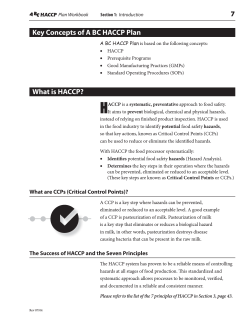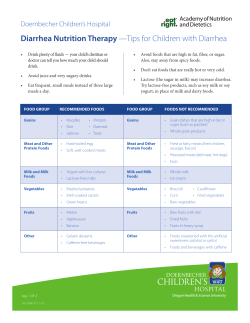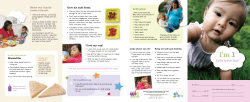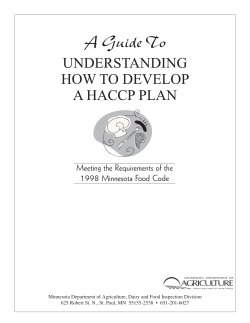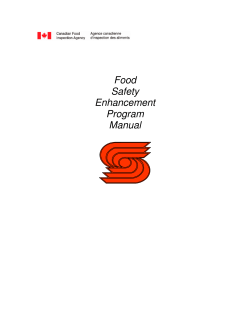
Industry Food Safety Challenges in The Crazy-quilt of Governmental Codes
Industry Food Safety Challenges in The Crazy-quilt of Governmental Codes Chuck Catlin R.S. M.P. A Director of Quality Assurance & Food Safety P.F. Chang’s China Bistro Inc. Who is Responsible For Food Safety at Foodservice and Retail food Stores? • • • • Government? Academia? General Public? Industry? • Answer…..INDUSTRY IS RESOPNSIBLE What Do I mean by Crazy-quilt of Government Codes? • There over 3000 units of government and many of them have a role in food regulation. • Numerous jurisdictions have “their version” of the food code. • Each has their version highlighting their favorite violations that are prominently noted on their forms. Forty-nine (49) of the 50 States adopted codes patterned after the 1993, 1995, 1997, 1999, 2001 or 2005 versions of the Food Code. These represent 95.5% of the US population. AGENDA Heath Department I • As of March 2010 The Crazy-quilt of Governmental Codes Source: FDA.gov With all these codes how do you know what the rules are? • We have shared responsibilities at the national level between CDC, FDA, USDA and EPA. • At the state level you have either the state health department or the department of agriculture. • At the local level you can have the county or the local municipality regulating food safety. • What you have is thousands of units of government inspecting food service operations. Who Owns Food Safety? • FDA creates the food code as if they are choosing a new Pope: – It starts out with recommendations from the Conference for Food Protection – After starting the revision it’s a secret process – FDA makes arbitrary decisions despite the fact that topics are still in committees. (i.e. new terms) • States then “tweak” the code to meet current laws or traditions. • Counties and municipalities then “massage” the code. What Else? • Each jurisdiction has their own inspection form. • Inspector competencies vary from Registered Sanitarians to the mayor’s grandson Billy JoeBob Buford. What kind of training is required for regulatory inspectors? • There is currently no standard training required. • And no required CEU’s. The Process is Broken! What Are The solutions? • One federal agency handling food safety • One Food Code for the entire country • Arizona HACCP Alliance had the solution What is the definition of Food Safety? – Active managerial control of the risk factors. What was the Arizona HACCP Alliance? • It was a partnership between the government and industry to see if regulatory verification programs can be developed to focus on the active managerial control of CDC risk factors. • The partnership included industry training to help retail food establishments effectively use food safety management systems. Code name….HACCP The Arizona HACCP Alliance • Enhance communication between regulatory and industry partners. • Develop a regulatory inspection methodology that: – – – – – Encourages industry to create food safety systems Reinforces industry developed systems Improve consistency in regulatory inspections Train inspectors / Industry Measuring active managerial control of the risk factors ARIZONA HACCP ALLIANCE PROJECT PROJECT DESIGN AND METHODLOGY 15 Arizona HACCP Alliance (1997) • FDA (Regional Food Specialist) • AZ Department of Health Services • 5 AZ Counties: – – – – – Coconino Maricopa Pima Pinal Yavapai • Industry Participants AZ HACCP ALLIANCE PROJECT’S SCOPE Facilities • Darden - Red Lobster Olive Garden 12 12 • Jack in the Box 114 • Taco Bell 113 TOTAL 251 17 AZ HACCP ALLIANCE PROJECT’S SCOPE Facilities • Independent Restaurants: - Participation in Workshops 38 18 HACCP ALLIANCE PROJECT DESIGN • Participants Were Divided Into Two Tiers: – Tier One – have food safety systems • System Verification – Tier Two – one or more components missing • Risk Control Plans FOOD SAFETY ACTION PLANS DATA ANALYSIS - TIER TWO • Industry Food Safety Action Plan/Time Lines: - 38 Independent Industry Operations Represented @ Workshops - 38 Of These Independent Operators Developed Food Safety Action Plans @ the Workshops (100%) - 25 Independent Operators Attempted to Implement their Action Plans (66%) 22 FOOD SAFETY ACTION PLANS DATA ANALYSIS - TIER TWO • Industry Food Safety Action Plan/Time Lines: - 22 Independent Operators were successful in implementing some aspects of their action plan within the 6 month period (58%) - 18 Independent Operators successfully developed management systems to control a specific foodborne illness risk factor within their facility (47%) 23 FOOD SAFETY ACTION PLANS DATA ANALYSIS - TIER TWO • Industry Food Safety Action Plan/Time Lines: - 12 Independent Operators developed additional action plans to address other foodborne illness risk factors (31.5%) 24 FOOD SAFETY ACTION PLANS DATA ANALYSIS - TIER TWO • Independent Restaurant Operators comments on the process: - Understood the HACCP management principles. - The process approach to HACCP worked best for their operations. - Human behavior issues were the most challenging issue in developing / implementing a food safety system. - Successful implementation requires management commitment to the process. - Regulatory support is essential for maintaining industry’s commitment to the process. 25 ARIZONA HACCP ALLIANCE PROJECT TIER ONE INDUSTRY OPERATIONS WITH FOOD SAFETY MANAGEMENT SYSTEMS 26 SYSTEMS VERIFICATION METHODOLOGY - TIER ONE Interview Session with Industry Operators: - Are the 7 principles of HACCP effectively used - Regulatory understood the system - Regulatory does NOT change the system 27 AVERAGE INSPECTION TIME • RED LOBSTER - 1st Quarter (66 Minutes) - 4th Quarter (61 Minutes) • OLIVE GARDEN - 1st Quarter (67 Minutes) - 4th Quarter (56 Minutes) 31 AVERAGE INSPECTION TIME • JACK IN THE BOX - 1st Quarter (59 Minutes) - 4th Quarter (60 Minutes) • TACO BELL - 1st Quarter (44 Minutes) - 4th Quarter (46 Minutes) 32 DATA ANALYSIS TOTAL OBSERVATIONS Total number of Items Verified 7900 Total number/(%) In Compliance with Industry Standards 7200 (92%) Total number of Regulatory Items Verified 4574 Total number/(%) In Compliance with Regulatory Standard 4321 (94%) Total number/(%) of items NOT OBSERVED 1441 (15%) 33 DATA ANALYSIS OBSERVATIONS - COOKING PROCESS Total number of Items Verified 600 Total number/(%) In Compliance with Industry Standard 578 (96%) Total number/(%) In Compliance with Regulatory Standards 587 (98%) Total number/(%) NOT OBSERVED 367 (38%) 34 DATA ANALYSIS OBSERVATIONS - COOLING PROCESS Total number of Items Verified 85 Total number/(%) In Compliance with Industry Standards 74 (87%) Total number/(%) In Compliance with Regulatory Standards 82 (96%) Total number/(%) NOT OBSERVED 255 (75%) 35 DATA ANALYSIS OBSERVATIONS - COLD HOLD PROCESS Total number of Items Verified 848 Total number/(%) In Compliance with Industry Standards 728 (86%) Total number/(%) In Compliance with Regulatory Standards 809 (95%) Total number/(%) NOT OBSERVED 26 ( 3%) 36 DATA ANALYSIS OBSERVATIONS - HANDWASHING Total number of Items Verified 545 Total number/(%) In Compliance with Industry Standards 511 (94%) Total number/(%) In Compliance with Regulatory Standards 518 (95%) Total number/(%) NOT OBSERVED 36 ( 6%) 37 AZ HACCP ALLIANCE DATA TRENDS • High % Compliance with Industry Critical Limits for Identified CCPs. • Even Higher % Compliance with Regulatory Critical Limits Established for these same CCPs 41 AZ HACCP ALLIANCE TAKE AWAYS • High % of Not Observed on key CCPs may indicate need to vary inspection times • Significant number of items would NOT be verified as part of traditional routine inspections because they are not specific Food Code Items. 42 AZ HACCP ALLIANCE TAKE AWAYS • The Pilot Study raised some interesting insights into potential flaws in the traditional inspection form as an accurate data collection tool for assessing the active managerial control of risk factors at the retail level. 43 AZ HACCP ALLIANCE TAKE AWAYS • For industry operations that have food safety management systems, the traditional inspection form provides very little information on the effectiveness of their systems and is a poor communication tool. 44 AZ HACCP ALLIANCE TAKE AWAYS • Custom Verifications of industry food safety management systems did not increase the inspection time. 45 AZ HACCP Alliance SUMMARY • A program where industry and government were working together. • The program used industry established systems. • The health inspector and industry management were speaking to front line employees using the same terms. -When the health inspector and management used the same terms a powerful impactful message was sent to front line employees. • We saw significantly higher compliance rates – Better behaviors leads to improved food safety • These effective “custom” inspections don’t take any additional staff time and may be faster over time What Happened to the Alliance? • Some of the many of our learning's were put into the state code adoption (1999) • The program worked! • Industry is willing to pay for this type of system. • So let’s go! Let’s 86 “The Crazy Quilt of Government Codes” The Crazy-quilt of Governmental Codes Questions ARIZONA/RED LOBSTER HACCP ALLIANCE GUIDE This guide is intended to assist a Regulatory Official in identifying Red Lobster procedures and systems to verify that we ar e in compliance with the new Arizona Food Code. Please leave the card at the restaurant. Cooking, Holding & Cooling Temperature Controls y y n n n/o n/o n/a n/a n n/o n/a (Gr. Beef >160F; Fish & Shrimp>150F; Chicken, Soup, Stuffed items and Rice >165F, Beef/Steaks>150F. All foods are from approved sources, safe, unadulterated and honestly presented y n n/o n/a Food received in proper condition and temperature. Cooked potentially hazardous foods held at 130F or above. y n n/o n/a Shellfish tags kept as required. Potentially hazardous foods cooked to proper temperature. (Rice and butter on line held at >150F; Chowder and Gumbo in service area held at >150F; all items labeled with discard time.) y n n/o n/a Food Condition & Source y Potentially hazardous foods reheated properly. Prevention of Contamination y n n/o n/a Food separation, packaging, segregation and substitution methods are preventing food and ingredient contamination. y n n/o n/a Effective food contact controls are preventing food contamination. (Color coded tong system in use.) y n n/o n/a Food contact surfaces and equipment are cleaned frequently and properly to prevent food contamination. (Red bucket y n n/o n/a (Rice and Soup >165F.) y n n/o n/a Cooked potentially hazardous foods cooled properly. (Rice and Linguini immediately cooled in ice water bath to <40F within 4 hours.) y n n/o n/a Potentially hazardous foods held at proper cooling temperature. sanitizer at 100 ppm.) (Rice, Soup, Hot Butter and Bread held at >150F.) Food/Equipment Temp Food/Equipment Chicken/Grill Rice, Linguini/Walk-in Fish/Grill Gumbo/Service Area Whipped Butter/Service Area Freezers Chowder/Service Area Line Boxes Temp Food contact surfaces sanitized properly and approved equipment being used. Date Marking & Disposal y n n/o n/a Consumer Advisories & Protection y n n/o n/a n n/o n/a Employees hands and exposed arms clean and properly washed. y n n/o n/a Hand washing facilities available and functional. y n n/o n/a Employees using proper hand and arm cleaning procedures. y n n/o n/a Live animals handled properly. y n n/o n/a Person in charge requires employees to report illnesses. y n n/o n/a Employees eating, drinking, or using tobacco only in designated areas. (Covered drink cups with straw stored below Demonstration ofFood foodSafety safetyKnowledge knowledge Demonstration of y n n/o n/a Time as aaspublic Time Only a Foodhealth Safetycontrol Control y n n/o n/a n/o n/a Persons with discharges from eyes, nose and mouth prohibited from working with exposed food. y n n/o n/a Food handlers preventing contamination of ready-to-eat food by limiting bare hand contact to approved methods. (Disposable HACCP Plan HACCP planFollowed followed y n n/o n/a n n/o n/a HACCP plan followed properly. (Quick-Check in use and temperatures recorded on HACCP forms.) gloves or tongs used.) y Food holding and storage time is within food safety limits. (N/A-Time only is not an approved control at Red Lobster.) work area.) n Person in charge assigned, and demonstrates adequate food safety knowledge applicable to operation. (Manager and Assistant Manager(s) should have NRA ServSafe Certification and know Vital Few and Vital Knowledge.) (Lobsters) y Consumer advisories conducted properly. (Present in menu and/or table tent when applicable.) Employee Health & Hygiene y Foods are correctly date marked . Food handlers tasting food properly. Standard Operating Procedures y n n/o n/a Other critical and non critical items in compliance (if not, specify violations under comment section). NEED MORE INFORMATION? Please call 407-245-5162 if you have any questions on Red Lobster procedures, products, or systems. ARIZONA/OLIVE GARDEN HACCP ALLIANCE GUIDE This guide is intended to assist a Regulatory Official in identifying Olive Garden procedures and systems to verify that we are in compliance with the new Arizona Food Code. Please leave the card at the restaurant. Cooking, Holding & Cooling Temperature Controls y n n/o n/a Potentially hazardous foods cooked to proper temperature. (Gr. Beef >160F; Fish & Shrimp>150F; Chicken, Soup, and Lasagna, Stuffed Mushrooms >165F, Beef/Steaks>150F. y n n/o n/a Cooked potentially hazardous foods held at 130F or above. (Lasagna, Manicotti, Cannelloni and hot foods in “Crescor” holding units > 150F.) y n n/o n/a n n/o n/a n n/o n/a n n/o n/a All foods are from approved sources, safe, unadulterated and honestly presented y n n/o n/a Food received in proper condition and temperature. y n n/o n/a Shellfish tags kept as required. (N.A. at Olive Garden) Prevention of Contamination y n n/o n/a Food separation, packaging, segregation and substitution methods are preventing food and ingredient contamination. y n n/o n/a Effective food contact controls are preventing food contamination. (Color coded tong system in use. Cooked potentially hazardous foods cooled properly. (Pastas, soups and sauces immediately cooled in ice water bath (1/3 water, 1/3 ice & 1/3 product) to <40F within 4 hours. Bag chill soups and sauces stored with no more than 4 per sheet tray in walk-in. Pastas placed on sheet pans for storage in walk-in.) y y Potentially hazardous foods reheated properly. (Soups and Sauces >165F using boiling water in tiltkettle.) y Food Condition & Source Yellow sheet trays for raw chicken.) y n n/o n/a sanitizer at 100 ppm.) Potentially hazardous foods held at proper cooling temperature. Food/Equipment Temp Food/Equipment Chicken/Grill-Hot Pastas/Walk-in Fish/Grill-Hot Line Boxes Soups/Service Area-Hot Freezers Lasagna, Manicotti/Crescor-Hot Lasagna, Manicotti/Steam tables-Hot Temp Food contact surfaces and equipment are cleaned frequently and properly to prevent food contamination. (Red bucket y n n/o n/a Food contact surfaces sanitized properly and approved equipment being used. Date Marking & Disposal y n n/o n/a y n n/o n/a y n n/o n/a Consumer Advisories & Protection n n/o n/a Employees hands and exposed arms clean and properly washed. y n n/o n/a Hand washing facilities available and functional. y n n/o n/a Employees using proper hand and arm cleaning procedures. y n n/o n/a Live animals handled properly. y n n/o n/a Person in charge requires employees to report illnesses. y n n/o n/a Employees eating, drinking, or using tobacco only in designated areas. y n n/o n/a Persons with discharges from eyes, nose and mouth prohibited from working with exposed food. n n/o n/a Food handlers preventing contamination of ready-to-eat food by limiting bare hand contact to approved methods. (Disposable Time as aaspublic Time Only a Foodhealth Safetycontrol Control y n n/o n/a n n/o n/a Food holding and storage time is within food safety limits. (N/A-Time only is not an approved control at Olive Garden.) HACCP Plan HACCP planFollowed followed y n n/o n/a HACCP plan followed properly. (Quick-Check in use and temperatures recorded on HACCP forms.) gloves or tongs used.) y Person in charge assigned, and demonstrates adequate food safety knowledge applicable to operation. (Manager and Assistant Manager(s) should have NRA ServSafe Certification and know Vital Few and Vital Knowledge.) (N/A) y Consumer advisories conducted properly. Demonstration ofFood foodSafety safetyKnowledge knowledge Demonstration of Employee Health & Hygiene y Foods are correctly date marked . Standard Operating Procedures Food handlers tasting food properly. y n n/o n/a Other critical and non critical items in compliance (if not, specify violations under comment section). NEED MORE INFORMATION? Please call 407-245-4787 if you have any questions on Olive Garden procedures, products, or systems. ARIZONA/JACK IN THE BOX HACCP ALLIANCE GUIDE This guide is intended to assist a Regulatory Official in identifying Jack in the Box procedures and systems to verify that we are in compliance with the new Arizona Food Code. Please leave the card at the restaurant. (See Box below to obtain paper copy). Cooking, Holding & Cooling Temperature Controls y n n/o n/a Potentially hazardous foods cooked to proper temperature. (Gr. Beef >155F; Fish >155F; Eggs -Yolk Hard; Bacon, Sausage, Egg Rolls, Chili and ALL CHICKEN are Fully-cooked at USDA Plant then heated to palatability - no minimum temperature.) y n n/o n/a Cooked potentially hazardous foods held at 130F or above. (No Food Condition & Source y n n/o n/a All foods are from approved sources, safe, unadulterated and honestly presented y n n/o n/a Food received in proper condition and temperature. y n n/o n/a Shellfish tags kept as required. (n/a at Jack in the Box.) hot holding over 30 mins; all items labeled with discard time.) y n n/o n/a Potentially hazardous foods reheated properly. Prevention of Contamination y n n/o n/a Food separation, packaging, segregation and substitution methods are preventing food and ingredient contamination. y n n/o n/a Effective food contact controls are preventing food contamination. (Raw ground beef patties should be y n n/o n/a (n/a No reheating of food at Jack in the Box.) y n n/o n/a Cooked potentially hazardous foods cooled properly. (n/a No cooling of food at Jack in the Box.) handled only with tongs - never with bare hands.) y n n/o n/a Potentially hazardous foods held at proper cooling temperature. (All Jack sauces and sliced cheeses meet criteria for non-potentially hazardous food as defined in AZ Code.) Food/Equipment Temp Food/Equipment sanitizer is effective at 150-300 ppm per manufacturer - use restaurant's QT 30 test strips.) Temp 350°F Cooked Rice ≥140°F not <325 365°F not <350 Grill and fryer cooking timers used 100% of the time (n/a for eggs) Minimum of one Certified Grill Employee working Grill. Cook visually inspects hamburger patties (not pink) and eggs (not runny). y n n/o n/a Grill Surface (1 lane may be 375°) Fryers (Shortening) Food contact surfaces and equipment are cleaned frequently and properly to prevent food contamination. (Jack's Quat Food contact surfaces sanitized properly and approved equipment being used. Date Marking & Disposal y n n/o n/a Foods are correctly date marked . (Jack in the Box labels with discard/destroy date and/or time. Person in charge should be able to show you chart that is used to determine date.) Consumer Advisories & Protection Employee Health & Hygiene * y n y n n/o n/a Employees hands and exposed arms clean and properly washed. y n n/o n/a Hand washing facilities available and functional. y n n/o n/a Employees using proper hand and arm cleaning procedures. n/o n/a y n n/o n/a Person in charge requires employees to report illnesses. y n n/o n/a Employees eating, drinking, or using tobacco only in designated areas. (Jack in the Box is a non-smoking facility.) y n n/o n/a Persons with discharges from eyes, nose and mouth prohibited from working with exposed food. y n n/o n/a Food handlers preventing contamination of ready-to-eat food by limiting bare hand contact to approved methods. (See State of Demonstration ofFood foodSafety safetyKnowledge knowledge Demonstration of n/o n/a Live animals handled properly. Time as aaspublic Time Only a Foodhealth Safetycontrol Control y n n/o n/a Food holding and storage time is within food safety limits. HACCP Plan HACCP planFollowed followed y n n/o n/a HACCP plan followed properly. (Review HACCP Shift Checklist.) Arizona guidance document on the back of this card.) n/o n/a Person in charge assigned, and demonstrates adequate food safety knowledge applicable to operation. (Manager and Assistant Manager(s) should have NRA ServSafe Certification.) (n/a at Jack in the Box.) y n Consumer advisories conducted properly. (n/a at Jack in the Box.) y n y n n/o n/a Standard Operating Procedures Food handlers tasting food properly. (n/a at Jack in the Box.) y n * Hourly Handwash Program When Inspector arrives at restaurant, he/she should be able to verify that Handwashing timer is activated. When timer sounds, every employee should (one at a time) leave his/her station and wash hands properly. Handwashing should be completed within 10 minutes of the timer sound. Person in charge should initial Handwash Log on HACCP Shift Checklist after everyone has washed hands properly. n/o n/a Other critical and non critical items in compliance (if not, specify violations under comment section). NEED MORE INFORMATION? Please call the QA Hotline at 1-800-500-5225 if you have any questions on Jack in the Box procedures, products, or systems or wish to obtain a paper copy of this guide.
© Copyright 2025

